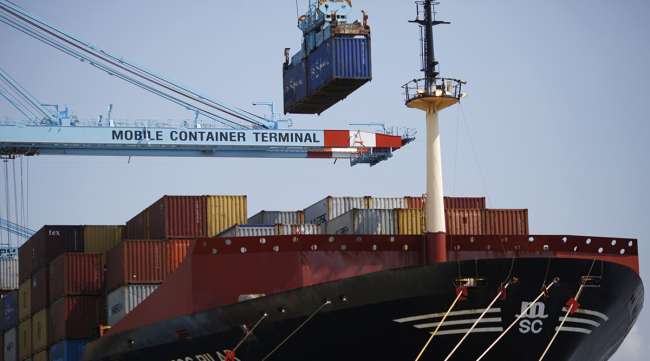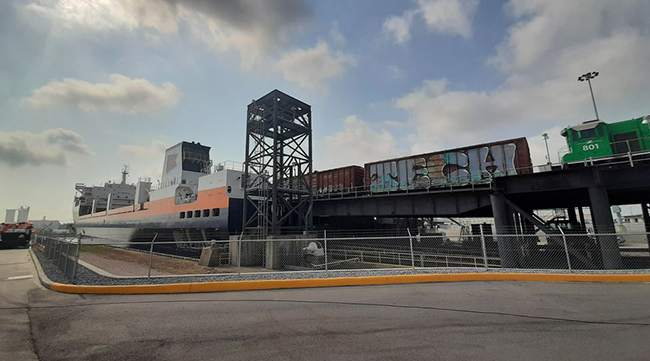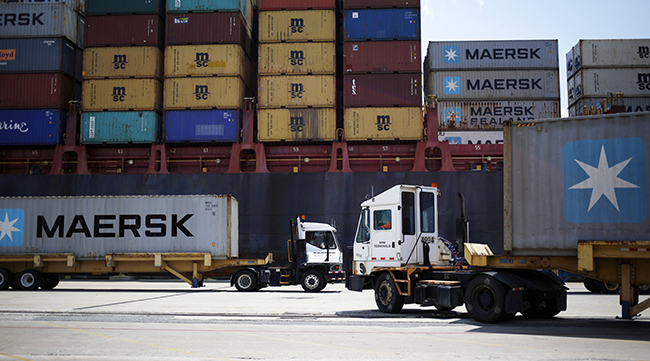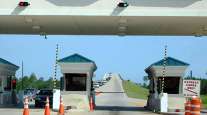Alabama Port Study Highlights Growth, Economic Impact

[Stay on top of transportation news: Get TTNews in your inbox.]
The Alabama State Port Authority has released a new study showing significant growth in jobs, tax revenue and general economic impact since 2019, underscoring the port’s place as a major economic driver in the state.
The study covering calendar year 2021 is the first of its kind since a study of 2019. It was conducted for the Port Authority by Martin Associates, a research and consulting firm that specializes in economic studies for ports.
Among its major findings: Port facilities provided 21,020 direct jobs, plus 18,885 induced jobs (those created by the purchases and service needs of people directly employed by the port) and 10,795 indirect jobs (those created by the purchases and service needs of companies directly impacted by port activity).
The study says that total of 50,700 is further amplified by 262,196 “related user jobs,” meaning jobs “with shippers and consignees (exporters and importers) using the marine terminals for shipment and receipt of cargo.” These businesses “are concentrated with the state’s auto manufacturing, retail distribution and steel manufacturing, as well as paper/pulp manufacturing industries and chemical industries.”
In October the state released employment figures showing that an estimated 2,234,948 people were working in September. The port’s most modest figure, the 21,020 direct jobs, amounts to nearly 1% of the jobs in the state. Its boldest, that a grand total of 312,896 jobs are either created by the port or by businesses that depend on the port, suggests that 14% of the jobs in the state are touched by the port in some way large or small.

Rail cars and an engine operated by the Alabama State Port Authority’s Terminal Railway. (Lawrence Specker/Tribune Content Agency)
John C. Driscoll, director and CEO of the Alabama Port Authority, said that figure is realistic.
“The one that we are most proud of and the one that kind of drives us is the jobs that are generated by port activity,” he said, “and those numbers have just about doubled [from 2019 to 2021]. Right now they’re 312,000-plus. That to me is one of the most important ones, that the activities that come in and out through the port generate good-paying jobs throughout the state.”
“The other big area that you’ll see [from the study] is really just the economic value of what comes in and out of the port, and that’s tripled, right, to $85 billion,” Driscoll said. “I think previously it was $26.8 billion. That is something that has really grown.”
“We’re a very diversified port,” said Driscoll. “We have a lot of different types of not only types of shipping activities, but a lot of different commodities, a lot of different modes of transportation — whether it’s barge, rail, over-the-road, whether it’s containerized, bulk, break-bulk, roll-on/roll-off — we really pretty much touch the gamut.”
As with the employment figures, that $85 billion breaks down into a spectrum: $4.4 billion in direct business revenue, $2.6 billion in “re-spending and local consumption,” and $78 billion in “related user output.” That last part is “the value of the output to the state of Alabama that is created due to the cargo moving via the seaport terminals. This includes the value added at each stage of producing an export cargo, as well as the value added at each stage of production for the firms using imported raw materials and intermediate products that flow via the Port of Mobile marine terminals and are consumed and produced by industries within the state.”
A tally of $19.2 billion in personal income and local consumption includes $4.5 billion attributed to the port itself and $14.7 billion in payroll at related users. On the tax side of the ledger, “State and local taxes supported by activity at the marine terminals totaled $2 billion, which includes $479.3 million of direct, induced and indirect state and local tax revenue as well as nearly $1.6 billion of state and local taxes that were supported by the economic activity of related users of the cargo moving through the port.”

TT's Eugene Mulero joins host Mike Freeze to discuss the midterm elections, and what the fight for control of Congress will mean for trucking. Tune in above or by going to RoadSigns.ttnews.com.
Meanwhile the container terminal operated by APM Terminals has broken a series of records this year, recently handling more than 50,000 container units per month and heading for a best-ever year of more than 500,000 container units. According to the port authority, Mobile has had the fastest growing container terminal in the country over the past five years, with 54.9% growth in volume since 2017.
The snapshot provided by the study has some context that suggests bigger things are coming. Firstly, it likely is skewed to some extent by the COVID-19 pandemic. 2019 was the last calendar year before the pandemic hit, but 2021 was a year of struggle to return to normalcy.
“It’s obviously guesswork,” said Driscoll. “I’m sure that has had some impact. It’s hard for me to tell exactly what that would be.” It’s a mixed bag: While the pandemic did slow down some sectors of the economy, related supply chain issues that jammed up some of the nation’s biggest ports also created new opportunities for Mobile, as shippers explored their options.
Secondly, the port is the subject of multiple major expansion projects that will pay off in dramatically increased capacity over the next few years. The U.S. Army Corps of Engineers is at work deepening the channel that cargo ships use to transit Mobile Bay. A new phase of expansion work on the container terminal will raise its capacity to more than a million container units per year. Driscoll said APM had recently finalized an order for two new cranes to join the four now in service.
More: The port, the state and a partner railroad are involved in a major project to open up container rail shipping directly from the port to Birmingham and points north. Another big project, involving the construction of a container terminal in Montgomery, will facilitate container rail shipping to that area. A 130-acre logistics park will provide additional warehouse and distribution capability near the intermodal transfer facility where containers are loaded onto railcars, and a new overpass will provide an improved connection to that facility.

Trucks carry shipping containers next to a cargo ship docked in the APM Terminals yard at the Port of Mobile. (Luke Sharrett/Bloomberg News)
“With all these investments that the state has made in very important things … we haven’t seen the benefits of that yet,” said Driscoll. “It looks like the growth potential is only going to continue to go up. Following these kind of incredible numbers is going to be a tall order, but still, the glide path is still very positive.”
The campaign of investment in the port over the last decade has come not just from the port, its partners and the state, but from the federal government as well. One big federal advocate, outgoing Sen. Richard Shelby (R-Ala.), took satisfaction in the new study.
“These results are cause for celebration throughout Alabama,” said Shelby, vice chairman of the Senate Appropriations Committee. “The impact that the Port of Mobile has already had on Alabama’s economy is remarkable. I am proud to witness this great news and believe these numbers will continue to improve.
“I have long known that Alabama’s largest port could have a pivotal impact on the growth of our state. Throughout my career, I’ve focused on projects that aim to position Alabama for long-term success, and the port has been one of those priorities,” Shelby said. “Its rise is attributable to everyone who has been involved in promoting its growth and the many ways it benefits Alabama. This is just the beginning.”
While it seems the Port of Mobile is positioning itself well to handle further growth, the possibility of a global economic downturn serves as a reminder that nothing is guaranteed.
“There are naysayers out there that the economy will slow down,” Driscoll said. “When that happens, global movements of cargo do slow down. It depends on what sector you’re in and what commodity you’re talking about, but they’re susceptible to that like other commodities.”
It looks like the growth potential is only going to continue to go up. Following these kind of incredible numbers is going to be a tall order, but still, the glide path is still very positive.
John C. Driscoll, director and CEO of the Alabama Port Authority

For now, the specific outcome of a slowdown is hard to predict. However, Driscoll said he thinks that the port will hold on to gains made during the turmoil of the pandemic. Generally, he said, once shippers have made the decision to relocate traffic from one port to another, they don’t casually revert to previous connections.
“Generally customers, once they switch, they change their whole supply chain system,” he said. “They don’t switch back unless they have a reason to switch back, i.e. our service suffers [and] doesn’t meet their requirements. So once a customer shifts, it generally is pretty sticky.”
A study like the one released by the port can provide a justification for continued investment. While the array of expansion projects already in the works is large, Driscoll said there’s always a need for more.
It starts with basic facility maintenance, he said. “Some of our infrastructure that we have at the main docks dates back to the ’20s, ’30s, ’40s,” he said. “We’re looking at doing some things to make sure that those are upgraded so we can handle the larger equipment that needs to sit on the docks. We’re doing one project right now but there’s a couple others we have to do.”
Other ongoing and future projects will add container rail connections to north Alabama and capital improvements at the McDuffie Coal Terminal, which nowadays deals mostly in exports of metallurgical-grade coal mined in Alabama.
“Just this year at McDuffie we’re investing $44 million,” Driscoll said. “We have $127 million in Cap Ex [capital expenditures] in 2023. So we’re not sitting down. We’re investing.”
“These numbers help us see, OK, what have we done, where are we based on what we have done already, where can we go in the future,” Driscoll said. “This shows a little bit about some of the decisions we have made in the past, and what does that mean to the state, and we’ll use that probably toward trying to continue the upward trend in growth throughout the next 10, 20, 30, 40 years.”
Want more news? Listen to today's daily briefing below or go here for more info:
Distributed by Tribune Content Agency, LLC




